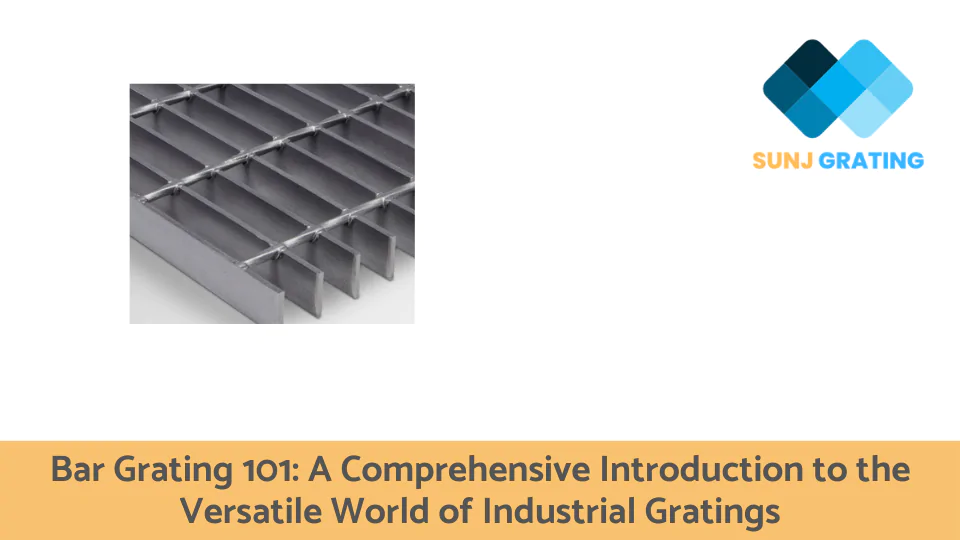Are you struggling to understand the concept of bar grating and its role in today’s industrial world? Are the technical aspects, benefits, and applications puzzling? We’ve got you covered.
Understanding the concept of bar grating truly is critical, particularly for individuals involved in construction, architecture, or any sector where safety and efficient operation are of paramount importance.
Bar grating, whether made from steel, aluminum, or other sturdy materials, plays an instrumental role in creating reliable, durable surfaces for various purposes – from walkways and platforms to drainage covers and fencing.
Keep reading, as we delve into this topic further. Not only will you get a firm grasp of bar grating basics, but you will also comprehend its impactful role in the industrial world. With this knowledge, you’ll be better equipped to make informed decisions in your work! So, let’s decode the world of bar grating together.
1. Understanding Bar Grating

A. Definition of Bar Grating
Bar grating refers to a series of metal bars positioned in a systematic and parallel manner, subsequently interconnected by additional bars, which are welded or locked at right angles. This resultant rectangular or square pattern creates a robust, high strength to weight ratio grid that can be employed in diverse applications.
The usage of bar grating spans across various sectors like industrial, architectural and infrastructure due to its resilience, versatility and economic advantages.
B. Brief History and Development of Bar Grating in the Industrial Sector
The concept of bar grating was born out of necessity during the industrial revolution when new forms of grating were required to cater to the evolving industrial landscape. The early versions were simple grid structures made from iron bars and used primarily in factories for floor spaces or incorporated into machinery.
In the mid-19th century, the increasing pressure of heavy wheel traffic led to the adoption of bar grating for bridge decking. The durability and strength of bar grating allowed for better weight distribution, making it the ideal choice for this purpose.
Over the years, the applications of bar grating have expanded vastly. It evolved from a basic functional element to an essential component in the architectural, infrastructure and industrial sectors. Today, with advancements in technology and manufacturing processes, bar gratings are available in diverse materials like steel, aluminum and fiberglass, catering to different requirements and conditions.
C. Basic Components and Design of a Bar Grating
Bar grating is composed of two main elements: bearing bars and cross bars. The bearing bars are the load-carrying members that run in the direction of span. They are the main structural component that sustains the weight. The cross bars, on the other hand, maintain the spacing and hold the bearing bars in place. Depending on the manufacturing process, they are either welded or mechanically locked to the bearing bars.
The design of a bar grating is contingent on its intended application. The gap or spacing between the bars often determines the load capacity, light passage, air ventilation, and material passage. Furthermore, the choice of material for the bar grating significantly impacts its corrosion resistance, strength, appearance, and overall cost.
2. Types of Bar Grating

In the realm of industrial flooring, bar gratings are a popular choice due to their durability, versatility, and variety. Each type of bar grating serves a unique purpose and is perfect for certain applications. Here are several types of bar grating we’ll be exploring today:
Welded Steel Grating
As the name implies, this type of grating involves the process of welding the cross-bar elements onto the bearing bars to ensure they firmly hold in place. This fusion provides a rigid, durable, and reliable structure that could withstand heavy loads and harsh conditions. Welded steel grating is the most commonly used due to its high strength-to-weight ratio and economical production process.
Swage Locked Grating
Swage locked grating entails the process of permanently locking the cross bars to the bearing bars, by applying high hydraulic pressure. This process doesn’t require the use of rivets, bolts, or welds, and results in a grating that’s highly durable and flexible, making it suitable for architectural applications.
Press-Locked Grating
Press-locked grating involves the use of extreme hydraulic pressure to embed the cross bars into the bearing bars. This process results in a smooth surface and is often used in architectural applications for its aesthetic appeal. Despite its elegant appearance, press-locked grating offers high stability and load-bearing capacity.
Overview of each type and their unique characteristics
| Welded steel grating | Economic efficiency and durability |
| Press-locked grating | pedestrian comfort and safety |
| Swage-locked grating | Flexibility and aesthetic appeal |
3. Advantages of Bar Grating

Strength and Durability
Firstly, the strength and durability of bar grating are unparalleled. Constructed from sturdy materials such as steel, aluminum, or stainless steel, bar grating is designed to endure heavy loads and withstand harsh environmental conditions. This robustness ensures longevity, reducing the need for frequent replacements and thereby offering cost-effectiveness.
Versatility and Adaptability
Secondly, bar grating is celebrated for its versatility and adaptability. It can be customized to accommodate a wide array of shapes, sizes, and specifications, making it suitable for diverse applications. Whether it’s deployed for industrial walkways, drainage covers, or architectural elements, bar grating can be tailored to meet the unique requirements of each project.
Ease of Installation and Maintenance
Thirdly, the ease of installation and maintenance associated with bar grating is another significant advantage. Its lightweight nature facilitates straightforward installation, while its open design allows for effortless cleaning and upkeep. This not only saves time and labor but also contributes to the grating’s longevity.
Safety and Comfort
Lastly, bar grating enhances safety and comfort. Its design promotes excellent traction, minimizing the risk of slips and falls. Furthermore, its open structure allows for the free passage of air, light, and heat, fostering a more comfortable environment.
In conclusion, the benefits of bar grating, including its strength, durability, versatility, ease of installation and maintenance, and its contribution to safety and comfort, make it an exceptional choice for a broad spectrum of applications.
4. Applications of Bar Grating

Bar grating is a versatile material that finds a wide range of applications in various industries due to its durability, strength, and adaptability. This article explores the different uses of bar grating in industrial, architectural, and specialized contexts.
Industrial Uses of Bar Grating
In the industrial sector, bar grating is extensively used due to its strength, durability, and ability to withstand heavy loads. It is commonly used to construct walkways and platforms in factories, warehouses, and other industrial facilities. These walkways provide safe and secure paths for workers, machinery, and materials to move around.
Bar grating is also used to create drainage covers. Its open design allows water and other fluids to pass through while providing a sturdy surface to walk or drive on. This is particularly useful in industries where liquids are commonly used or where spillages may occur, such as in chemical plants or food processing facilities.
Architectural Uses of Bar Grating
Beyond its industrial applications, bar grating is also used in various architectural contexts. It is often used to construct fencing due to its strength and aesthetic appeal. The open design allows for visibility while still providing a secure barrier.
Bar grating is also used to create sunshades and building facades. As a sunshade, it can reduce heat and glare while allowing natural light to pass through. When used as a facade, it can give buildings a modern, industrial aesthetic while providing ventilation and light.
Specialized Uses of Bar Grating
In addition to its industrial and architectural uses, bar grating is also used in specialized applications. For instance, it is used to construct stair treads in both industrial and commercial settings. The grating provides excellent traction, reducing the risk of slips and falls.
Bar grating is also used to create catwalks in industries such as entertainment and fashion. These catwalks are lightweight yet strong, making them ideal for these applications.
5. Choosing the Right Bar Grating
| 1 | Location |
| 2 | Material |
| 3 | Type of Grating |
| 4 | Location |
Making the right choice of bar grating for your project or facility involves a delicate touch, a thorough understanding of the specifics, and a careful consideration of numerous factors.
A. Factors to Consider: Load Capacity, Material, Type of Grating, Location
Choosing the right bar grating for your project is a crucial decision that can significantly impact the safety, functionality, and aesthetics of your space. Several factors need to be considered to ensure that you select the most suitable bar grating.
The first factor to consider is the load requirements. The bar grating you choose must be able to withstand the weight and type of load it will be subjected to. This includes considering the weight of individuals, equipment, or vehicles that may use the grating.
Environmental conditions are another critical factor. If the grating is to be used outdoors or in corrosive environments, materials that resist rust and corrosion, such as stainless steel or galvanized steel, would be ideal.
The choice of material is also crucial. While steel is a common choice due to its strength and durability, other materials like aluminum may be more suitable for certain applications due to their lighter weight and resistance to corrosion.
Aesthetic preferences should also be considered, especially for architectural applications. The design and finish of the grating can significantly impact the overall look of the space.
B. Importance of Quality and Standards
While considering these factors, it’s crucial not to compromise on the quality of the bar grating. High-quality grating will be more durable, require less maintenance, and provide better safety.
Adherence to standards is another critical aspect. Various standards govern the design, manufacture, and installation of bar grating, ensuring that it meets specific safety and performance criteria. Choosing a manufacturer that adheres to these standards can provide assurance of the grating’s quality and safety.
Conclusion
In conclusion, it cannot be overstated just how pivotal bar grating is in a variety of applications. It is more than just a collection of bars. It serves as a key player in various facets of industry, construction, and even our daily lives. The versatility of bar grating is reflected in its myriad uses, from floorings, platforms, walkways, safety barriers, ventilation grates, to drainage covers. Its durability, strength, and adaptability make it an invaluable tool in many settings.


